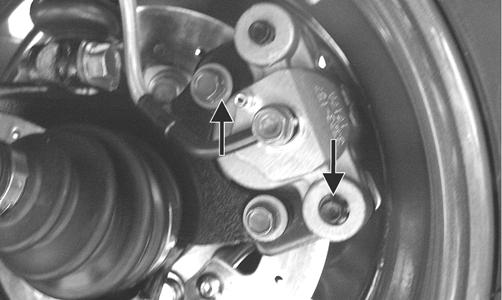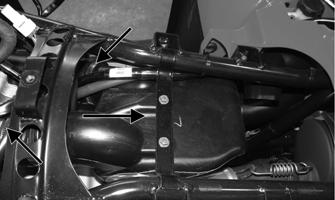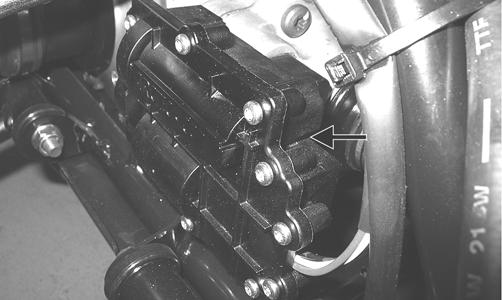
13 minute read
Steering/Frame
The following steering components should be inspected periodically to ensure safe and proper operation.
A.Handlebar grips not worn, broken, or loose.
B.Handlebar not bent, cracked, and has equal and complete full-left and full-right capability.
C.Steering post bearing assembly/bearing housing not broken, worn, or binding.
D.Ball joints not worn, cracked, or damaged.
E.Tie rods not bent or cracked.
F.Knuckles not worn, cracked, or damaged. G.Cotter pins not damaged or missing.
Steering Post/Tie Rods
REMOVING 1.Remove the front body panel/fender (see Front Body
Panel/Fender in this section). 2.Remove the steering post cover; then remove the cap screws securing the handlebar caps and move the handlebar out of the way. Account for the two handlebar caps.
KC0058
3.Remove the cap screws securing the upper steering post to the frame. Account for the housing cap, outer housing, and inner housing.
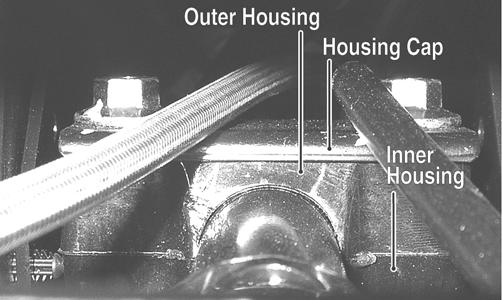
KC307A
4.Remove the cotter pins from the inner tie rod ends; then remove the nuts and disconnect the inner tie rod ends.
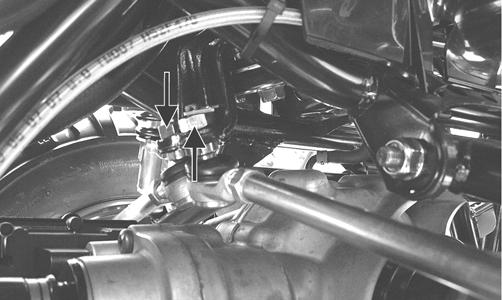
KC184A
NOTE: If tie rods are to be completely removed,
remove the outer tie rod ends from the knuckles at this time.
5.Remove the cap screw securing the lower steering post to the bearing. Account for a flat washer.
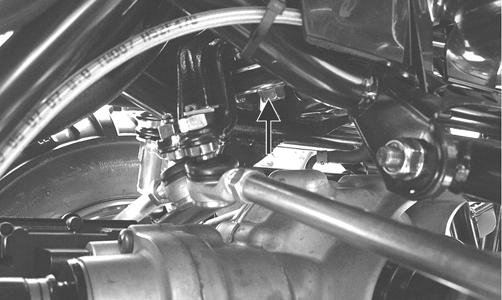
KC184B
6.Remove the steering post from the ATV. CLEANING AND INSPECTING NOTE: Whenever a part is worn excessively, cracked,
or damaged in any way, replacement is necessary.
1.Wash the tie rod ends in parts-cleaning solvent. Dry with compressed air. Inspect the pivot area for wear.
Apply a low-temperature grease to the ends.
Always wear safety glasses when using compressed air.
2.Inspect the tie rods for damaged threads or wear. 3.Inspect the tie rods for cracks or unusual bends. 4.Inspect all welded areas for cracks or deterioration. 5.Inspect the steering post and steering-post brackets for cracks, bends, or wear. 6.Inspect the bearing halves, bearing caps, and bearing housings for cracks or wear. 7.Inspect the handlebar tube for cracks, wear, or unusual bends.
8.Inspect the handlebar grips for damage or wear. INSTALLING 1.Install the steering post into the frame and secure the lower end in the bearing with a flat washer and cap screw. Tighten to 40 ft-lb.

KC184B
2.Apply grease to the inner and outer housings of the upper steering post support; then with the housing cap in place, secure with the cap screws. Tighten to 20 ft-lb.

KC307A
3.Using red Loctite #271 on the threads, install the tie rod ends into the lower steering post arm and tighten to 30 ft-lb; then install new cotter pins.

KC184A
4.Place the handlebar and caps in place on the steering post and with the handlebar correctly positioned, tighten the cap screws to 20 ft-lb.

KC0058
5.Install the steering post cover; then install the front body panel/fender (see Front Body Panel/Fender in this section).
Speedometer/LCD Gauge
REPLACING 1.Remove two machine screws securing the gauge pod to the handlebar; then lift the gauge pod up and disconnect the harness plug from the gauge.
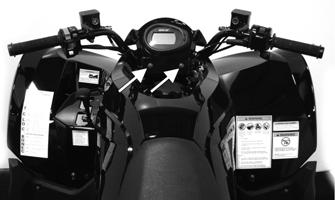
KC391B
2.Loosen the gauge mounting nuts and remove the gauge from the pod. the gauge pod with the machine screws. Tighten securely.
Handlebar Grip
REMOVING 1.Loosen but do not remove the cap screw in the end of the handlebar; then tap lightly on the head to dislodge the handlebar plug.
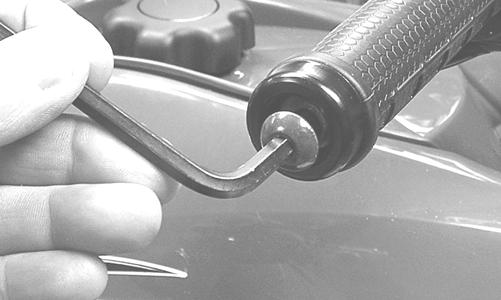
KC310
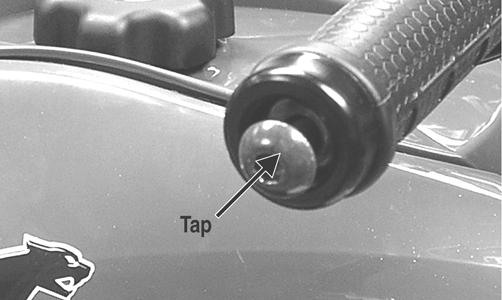
KC309A
2.Grasp the end and remove the cap screw, plug, and end cap.
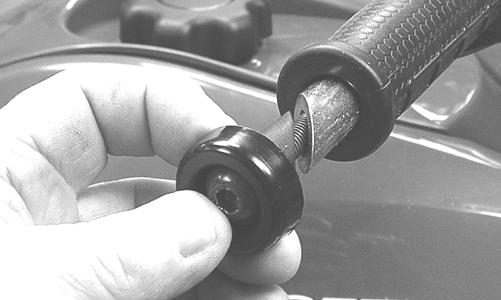
KC308
3.Using a sharp utility knife, split the handlebar grip from end to end and peel off the rubber. 4.Using an adhesive solvent, clean all glue residue from the handlebar.
INSTALLING 1.Apply a liberal amount of Handlebar Grip Adhesive to the inside of the new grip.
2.Slide the grip onto the handlebar until it is fully seated with the smooth part of the grip facing up. NOTE: A quick, firm push is required to seat the
grip completely on the handlebar. Install while the glue is wet.
3.Wipe off any excess glue; then secure the grip with the plug, end cap, and cap screw.
Throttle Control
REMOVING 1.Remove the two machine screws securing the throttle control to the handlebar.
2.Slide the grommet out of the lower half of the throttle control; then remove the cable from the actuator arm.
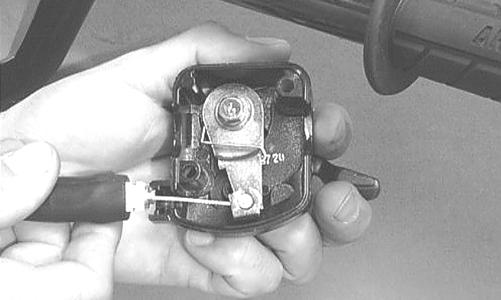
AF676D
3.Remove the cap screw, lock washer, and washer securing the actuator arm to the throttle control lever.
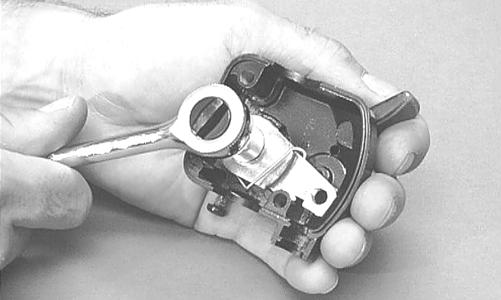
AF677D
4.Remove the actuator arm and account for a bushing.
Note the position of the return spring for installing purposes.
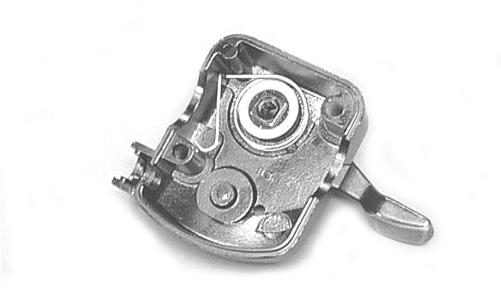
AF678D
INSTALLING 1.Place the return spring into the throttle control; then place the bushing and actuator arm into position.
Secure with the cap screw, lock washer, and washer.
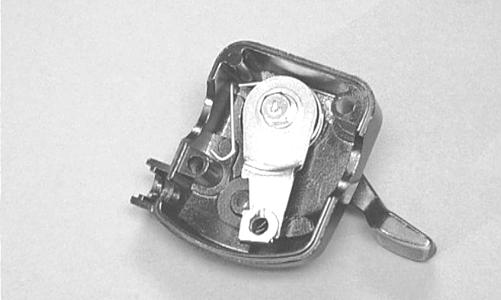
AF679D
2.Using a pair of needle-nose pliers, place the spring into position on the actuator arm.
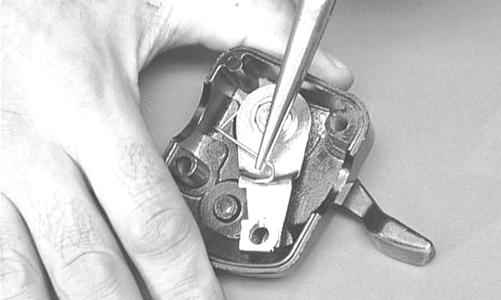
AF680D
3.Place the two halves of the throttle control onto the handlebar and secure with the two machine screws.
ADJUSTING To adjust throttle cable free-play, see Periodic Maintenance.
Steering Knuckles
REMOVING AND DISASSEMBLING 1.Secure the ATV on a support stand to elevate the wheel; then remove the wheel.
! WARNING
Make sure the ATV is solidly supported on the support stand to avoid injury.
2.Remove the wheel cap from the hub; then remove the cotter pin from the nut. 3.Remove the nut securing the hub. 4.Remove the brake caliper. 5.Remove the hub assembly. 6.Remove the cotter pin from the tie rod end and remove the tie rod end from the knuckle.
7.Remove the two cap screws securing the ball joints in the knuckle.
8.Tap the ball joint end out of the knuckle; then remove the knuckle.
9.Remove the snap ring from the knuckle; then remove the bearing.
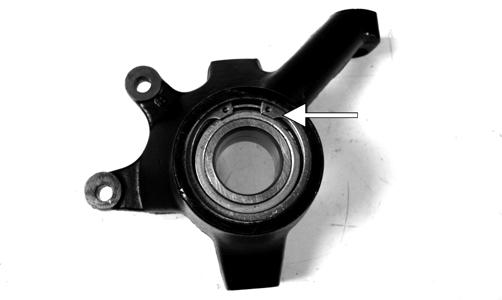
PR287A
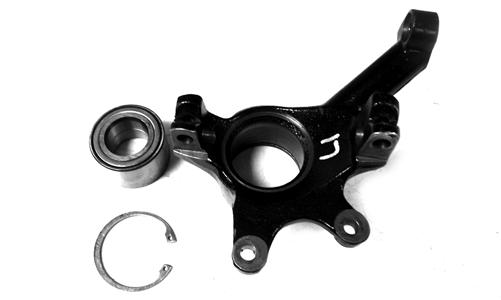
PR288
CAUTION
Use extreme care when removing the bearing. If the bearing is allowed to fall, it will be damaged and will have to be replaced.
CLEANING AND INSPECTING NOTE: Whenever a part is worn excessively,
cracked, or damaged in any way, replacement is necessary.
1.Clean all knuckle components. 2.Inspect the bearing for pits, gouges, rusting, or premature wear.
3.Inspect the knuckle for cracks, breaks, or porosity. 4.Inspect threads for stripping or damage. ASSEMBLING AND INSTALLING 1.Install the bearing; then install the snap ring making sure it seats into the knuckle.

PR287A
2.Install the knuckle to the upper and lower ball joints and secure with the two cap screws. Tighten to 35 ftlb.
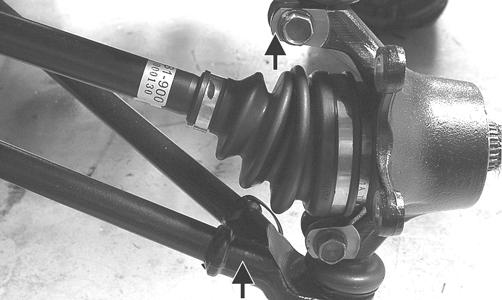
KC313A
3.Install the tie rod end and secure with the nut.
Tighten to 30 ft-lb; then install a new cotter pin and spread the pin. NOTE: During assembling, new cotter pins should
be installed.
4.Apply a small amount of grease to the hub splines. 5.Install the hub assembly onto the splines of the shaft. 6.Secure the hub assembly with the nut. Tighten only until snug.
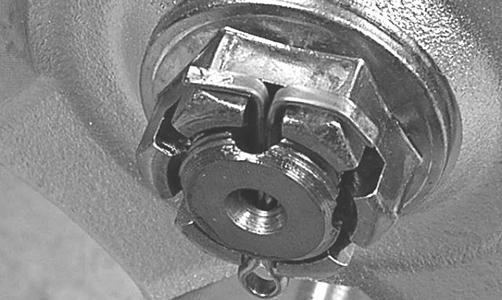
KC305
7.Secure the brake caliper to the knuckle with the
“patch-lock” cap screws. Tighten to 20 ft-lb.
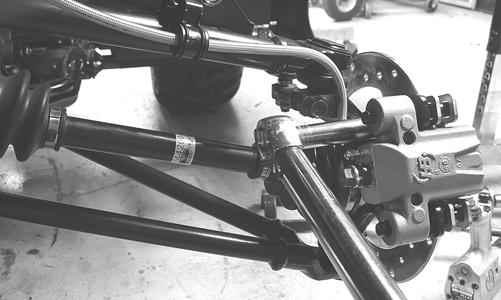
KC283
8.Pump the hand brake lever; then engage the brake lever lock.
9.Secure the hub nut (from step 6) to the shaft. Tighten to 200 ft-lb.
10.Install a new cotter pin and spread the pin to secure the nut.
11.Install the wheel; then using a crisscross pattern, tighten to 40 ft-lb. 12.Remove the ATV from the support stand.
Measuring/Adjusting ToeOut
1.Thoroughly wash the ATV to remove excess weight (mud, etc.). 2.Refer to the specifications and ensure the tires are properly inflated to the recommended pressure. NOTE: Ensure the inflation pressure is correct in
the tires or inaccurate measurements can occur.
3.Place the ATV in a level position taking care not to push down or lift up on the front end; then turn the handlebar to the straight ahead position. NOTE: When measuring and adjusting, there should
be a normal operating load on the ATV (without an operator but with Arctic Cat approved accessories).
4.Measure the distance from the outside edge of each handlebar grip to equal reference points on each side. 5.Adjust the handlebar direction until the two measurements are equal; then secure the handlebar. NOTE: Care must be taken not to allow the handle-
bar to turn while securing it.
NOTE: The front wheels do not have to be removed
to adjust the tie rod. Also, care should be taken not to disturb the handlebar position.
6.Using a permanent marker of some type, mark the center of each front tire (at a height parallel to the belly panel).
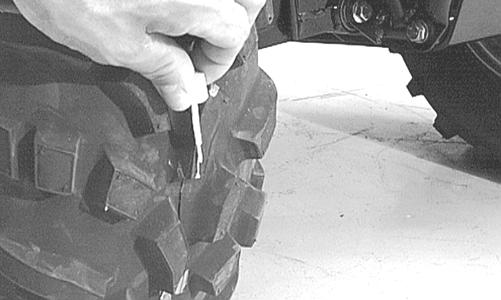
AF789D
7.Measure the distance between the marks (at a height parallel to the belly panel) at the front side; then record the measurement. 8.Push the ATV forward until the marks are parallel to the belly panel on the back side; then measure the distance between the marks.
9.The difference in the measurements must show 1/81/4 in. toe-out (the front measurement 1/8-1/4 in. more than the rear measurement). 10.If the difference in the measurements is not within specifications, adjust both tie rods equally until within specifications. NOTE: Prior to locking the jam nuts, make sure the
ball joints are at the center of their normal range of motion and at the correct angle.
733-559A
Front Bumper Assembly
REMOVING Remove the four front cap screws securing the bumper support tubes to the frame. INSTALLING Install the cap screws in the support tubes to frame. Tighten the cap screws securely.
Front Body Panel/Fender
REMOVING 1.Remove the seat; then remove four reinstallable rivets and the side panels.
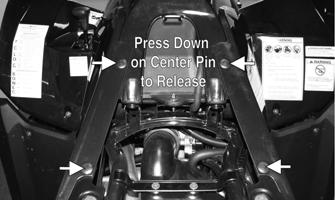
KC450A
2.Remove two cap screws and two reinstallable rivets; then remove the gas tank cap and remove the gas tank cover. Reinstall the gas tank cap.
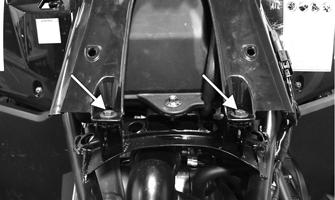
KC453A
3.Remove the shift lever knob. 4.Remove two reinstallable rivets, two fender bolts, and four cap screws; then lift the front fender panel off and set aside. Account for the shift lever spring.
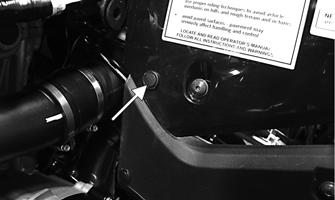
KC469A
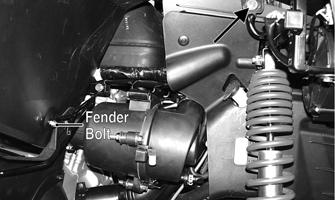
KC467A
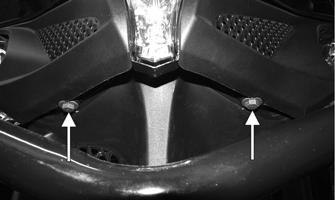
KC470A
CLEANING AND INSPECTING NOTE: Whenever a part is worn excessively,
cracked, or damaged in any way, replacement is necessary.
1.Clean all fender components with warm soap and water.
2.Inspect fenders for cracks or other damage. 3.Inspect for any missing decals. INSTALLING 1.Making sure the shift spring is in place and the shift lever is properly positioned, place the front body fender panel onto the ATV. 2.Loosely install the four cap screws and two finder bolts; then install and lock the two reinstallable rivets. 3.Place the gas tank cover into position and secure with the existing hardware; then install the two cap screws securing the rear of the panel to the frame.
Tighten all cap screws and fasteners securely. 4.Install the side panels and secure with the four reinstallable rivets; then install the seat.
Exhaust System
REMOVING MUFFLER 1.Remove the two exhaust springs at the muffler/ exhaust pipe juncture.
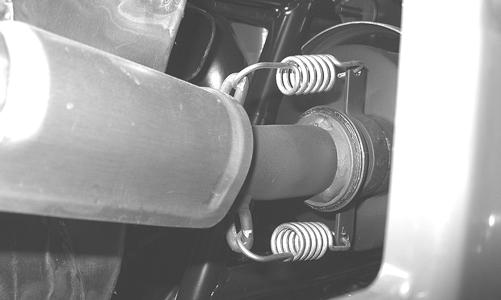
KC170
2.Slide the muffler rearward to clear the mounting lugs and remove the muffler. Account for a grafoil seal. INSPECTING MUFFLER NOTE: Whenever a part is worn excessively,
cracked, or damaged in any way, replacement is necessary.
1.Inspect muffler externally for cracks, holes, and dents.
2.Inspect the muffler internally by shaking the muffler back and forth and listening for rattles or loose debris inside the muffler.
NOTE: For additional details on cleaning the muf-
fler/spark arrester, see Periodic Maintenance.
INSTALLING MUFFLER 1.Using a new grafoil seal, place the muffler into position engaging the mounting lugs into the grommets; then slide the muffler forward.
2.Install the two exhaust springs.
Rear Body Panel
REMOVING 1.Remove the seat; then remove four cap screws securing the rear body panel/fender to the frame and the cap screws securing the rear fenders to the fender supports.
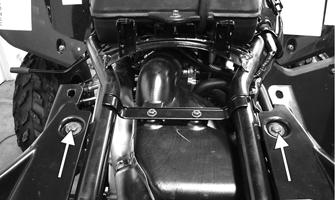
KC473A
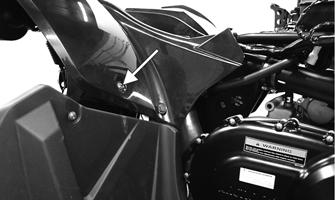
KC472A
2.Remove two reinstallable rivets securing the fenders to the footwells.
KC472A
3.Using a small screwdriver, remove the light connectors from the frame; then disconnect both connectors and remove the rear body panel/fender. CLEANING AND INSPECTING NOTE: Whenever a part is worn excessively, cracked,
or damaged in any way, replacement is necessary.
1.Clean all rear body panel components with warm soap and water. 2.Inspect side panels and rear body panel for cracks and loose rivets.
3.Inspect threaded areas of all mounting bosses for stripping. 4.Inspect for missing decals. INSTALLING 1.Place the rear body panel/fender in place on the
ATV; then secure with the cap screws on the frame and fender supports. Tighten all fasteners securely. 2.Connect the light connectors and secure to the frame.
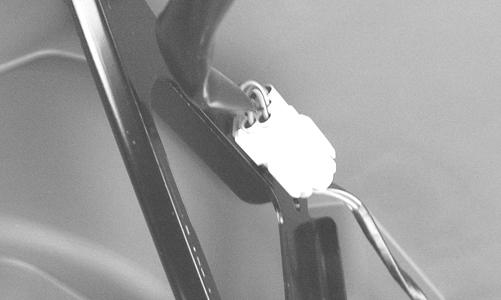
KC279
3.Secure the rear fenders to the footwells with the reinstallable rivets and lock.
4.Install the seat.
Seat
REMOVING/INSTALLING 1.To remove the seat, pull rearward on the latch release (located under the rear of the seat). Raise the rear of the seat and slide it rearward.
2.To lock the seat into position, slide the front of the seat into the seat retainers and push down firmly on the rear of the seat. The seat should automatically lock into position.
Troubleshooting
Problem: Handling too heavy or stiff Condition Remedy
1. Front wheel alignment incorrect 1.Adjust alignment 2. Lubrication inadequate 2.Lubricate appropriate components 3. Tire inflation pressure low 3.Adjust pressure 4. Tie rod ends seizing 4.Replace tie rod ends 5. Linkage connections seizing 5.Repair - replace connections
Problem: Steering oscillation Condition Remedy
1. Tires inflated unequally 1.Adjust pressure 2. Wheel(s) wobbly 2.Replace wheel(s) 3. Wheel hub cap screw(s) loose - missing 3.Tighten - replace cap screws 4. Wheel hub bearing worn - damaged 4.Replace bearing 5. Tie rod ends worn - loose 5.Replace - tighten tie rod ends 6. Tires defective - incorrect 6.Replace tires 7. A-arm bushings damaged 7.Replace bushings 8. Bolts - nuts (frame) loose 8.Tighten bolts - nuts
Problem: Steering pulling to one side Condition Remedy
1. Tires inflated unequally 1.Adjust pressure 2. Front wheel alignment incorrect 2.Adjust alignment 3. Wheel hub bearings worn - broken 3.Replace bearings 4. Frame distorted 4.Repair - replace frame 5. Shock absorber defective 5.Replace shock absorber
Problem: Tire wear rapid or uneven Condition Remedy
1. Wheel hub bearings worn - loose 1.Replace bearings 2. Front wheel alignment incorrect 2.Adjust alignment 3. Tire inflation pressure incorrect 3.Adjust pressure
Problem: Steering noise Condition Remedy
1. Cap screws - nuts loose 1.Tighten cap screws - nuts 2. Wheel hub bearings broken - damaged 2.Replace bearings 3. Lubrication inadequate 3.Lubricate appropriate components

